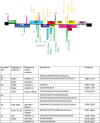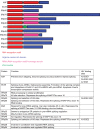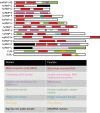Can the HIV-1 splicing machinery be targeted for drug discovery?
- PMID: 28331370
- PMCID: PMC5354533
- DOI: 10.2147/HIV.S120576
Can the HIV-1 splicing machinery be targeted for drug discovery?
Abstract
HIV-1 is able to express multiple protein types and isoforms from a single 9 kb mRNA transcript. These proteins are also expressed at particular stages of viral development, and this is achieved through the control of alternative splicing and the export of these transcripts from the nucleus. The nuclear export is controlled by the HIV protein Rev being required to transport incompletely spliced and partially spliced mRNA from the nucleus where they are normally retained. This implies a close relationship between the control of alternate splicing and the nuclear export of mRNA in the control of HIV-1 viral proliferation. This review discusses both the processes. The specificity and regulation of splicing in HIV-1 is controlled by the use of specific splice sites as well as exonic splicing enhancer and exonic splicing silencer sequences. The use of these silencer and enhancer sequences is dependent on the serine arginine family of proteins as well as the heterogeneous nuclear ribonucleoprotein family of proteins that bind to these sequences and increase or decrease splicing. Since alternative splicing is such a critical factor in viral development, it presents itself as a promising drug target. This review aims to discuss the inhibition of splicing, which would stall viral development, as an anti-HIV therapeutic strategy. In this review, the most recent knowledge of splicing in human immunodeficiency viral development and the latest therapeutic strategies targeting human immunodeficiency viral splicing are discussed.
Keywords: Rev; SR proteins; Tat; Vpr; alternative splicing; exonic specific silencer; exonic splicing enhancer; hnRNP; splicing based therapies.
Conflict of interest statement
Disclosure The authors report no conflicts of interest in this work.
Figures





Similar articles
-
RNA splicing at human immunodeficiency virus type 1 3' splice site A2 is regulated by binding of hnRNP A/B proteins to an exonic splicing silencer element.J Virol. 2001 Sep;75(18):8487-97. doi: 10.1128/jvi.75.18.8487-8497.2001. J Virol. 2001. PMID: 11507194 Free PMC article.
-
The hnRNP A1 protein regulates HIV-1 tat splicing via a novel intron silencer element.EMBO J. 2001 Oct 15;20(20):5748-58. doi: 10.1093/emboj/20.20.5748. EMBO J. 2001. PMID: 11598017 Free PMC article.
-
hnRNP A1 controls HIV-1 mRNA splicing through cooperative binding to intron and exon splicing silencers in the context of a conserved secondary structure.RNA. 2002 Nov;8(11):1401-15. doi: 10.1017/s1355838202023075. RNA. 2002. PMID: 12458794 Free PMC article.
-
Role of viral splicing elements and cellular RNA binding proteins in regulation of HIV-1 alternative RNA splicing.Curr HIV Res. 2006 Jan;4(1):43-55. doi: 10.2174/157016206775197655. Curr HIV Res. 2006. PMID: 16454710 Review.
-
Chapter 1. Regulation of HIV-1 alternative RNA splicing and its role in virus replication.Adv Virus Res. 2009;74:1-40. doi: 10.1016/S0065-3527(09)74001-1. Adv Virus Res. 2009. PMID: 19698894 Review.
Cited by
-
From Gene to Protein-How Bacterial Virulence Factors Manipulate Host Gene Expression During Infection.Int J Mol Sci. 2020 May 25;21(10):3730. doi: 10.3390/ijms21103730. Int J Mol Sci. 2020. PMID: 32466312 Free PMC article. Review.
-
Identification of host proteins differentially associated with HIV-1 RNA splice variants.Elife. 2021 Feb 25;10:e62470. doi: 10.7554/eLife.62470. Elife. 2021. PMID: 33629952 Free PMC article.
-
Transcriptomic Analysis Reveals Key Pathways Influenced by HIV-2 Vpx.Int J Mol Sci. 2025 Apr 8;26(8):3460. doi: 10.3390/ijms26083460. Int J Mol Sci. 2025. PMID: 40331967 Free PMC article.
-
Filgotinib suppresses HIV-1-driven gene transcription by inhibiting HIV-1 splicing and T cell activation.J Clin Invest. 2020 Sep 1;130(9):4969-4984. doi: 10.1172/JCI137371. J Clin Invest. 2020. PMID: 32573496 Free PMC article.
-
Sequence and Functional Variation in the HIV-1 Rev Regulatory Axis.Curr HIV Res. 2020;18(2):85-98. doi: 10.2174/1570162X18666200106112842. Curr HIV Res. 2020. PMID: 31906839 Free PMC article.
References
-
- Hryckiewicz K, Bura M, Kowala-Piaskowska A, Bolewska B, Mozer-Lisewska I. HIV RNA splicing. HIV AIDS Rev. 2011;10(3):61–64.
-
- Stoltzfus CM. Chapter 1 Regulation of HIV-1 Alternative RNA Splicing and Its Role in Virus Replication. Adv Virus Res. 2009;74:1–40. - PubMed
Publication types
LinkOut - more resources
Full Text Sources
Other Literature Sources
Research Materials

